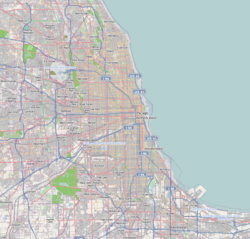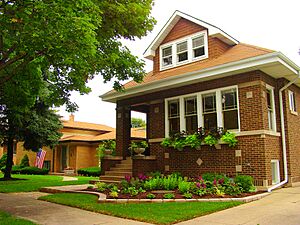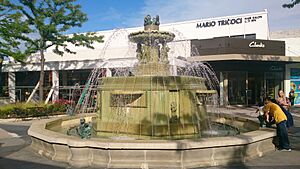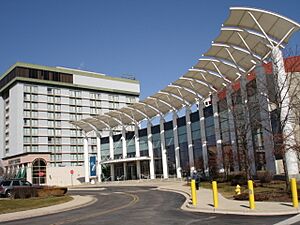Skokie, Illinois facts for kids
Quick facts for kids
Skokie, Illinois
|
|||
|---|---|---|---|
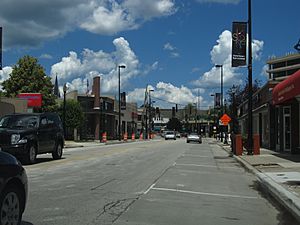
Downtown Skokie in 2013
|
|||
|
|||
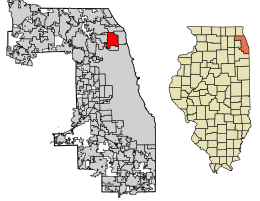
Location of Skokie in Cook County, Illinois
|
|||
| Country | |||
| State | Illinois | ||
| County | Cook | ||
| Township | Niles | ||
| Incorporated | 1888 | ||
| Government | |||
| • Type | Council–manager | ||
| Area | |||
| • Total | 10.06 sq mi (26.07 km2) | ||
| • Land | 10.06 sq mi (26.07 km2) | ||
| • Water | 0.00 sq mi (0.00 km2) 0% | ||
| Population
(2020)
|
|||
| • Total | 67,824 | ||
| • Density | 6,739.27/sq mi (2,602.03/km2) | ||
| Up 2.27% from 2000 | |||
| Standard of living (2011) | |||
| • Per capita income | $32,169 | ||
| • Median home value | $297,900 | ||
| ZIP code(s) |
60076, 60077, 60203
|
||
| Area code(s) | 847 & 224 | ||
| Geocode | 70122 | ||
| FIPS code | 17-70122 | ||
Skokie (pronounced SKOH-kee) is a village in Cook County, Illinois, United States. In 2020, about 67,824 people lived there. Skokie is located about 15 miles north of downtown Chicago. The name Skokie comes from a Potawatomi word that means 'marsh'. For many years, Skokie was known as "The World's Largest Village." Its streets connect to Chicago's street system, and the village has public transportation from the Chicago Transit Authority, linking it closely to the city.
Skokie started as a farming community settled by people from Germany and Luxembourg. Later, many Jewish people moved there, especially after World War II. In the mid-1960s, about 58% of the population was Jewish. Today, about 30% of residents are Jewish, and there are over a dozen synagogues. Skokie is also home to the Illinois Holocaust Museum and Education Center, which opened in 2009.
Skokie has been in the news twice because of important court cases that went to the United States Supreme Court. In the 1970s, a group wanted to hold a rally in Skokie. This led to a case called National Socialist Party of America v. Village of Skokie. The case was about the First Amendment, which protects freedom of speech. At that time, many Holocaust survivors lived in Skokie. Skokie lost the case, but the rally never happened there.
Contents
History of Skokie
How Skokie Began
In 1888, the community became an official village called Niles Centre. Around 1910, the spelling changed to "Niles Center." However, this name caused confusion with the nearby village of Niles for mail delivery. So, in the 1930s, people started a campaign to change the village's name. On November 15, 1940, residents voted to choose the Native American name "Skokie" instead of "Devonshire."
In the 1920s, during a time when many new homes were being built, large areas of land were divided into smaller lots. Many two- and three-story apartment buildings were constructed. The "Chicago"-style bungalow was a very popular type of house. This building boom stopped after the Great Crash of 1929 and the Great Depression. Building started again in the 1940s and 1950s when families from Chicago, part of the baby boom generation, moved to Skokie. Because of this growth, the village also developed many businesses, like the Old Orchard Shopping Center, which is now called Westfield Old Orchard.
In 1961, the first African-American family moved to Skokie. Groups that supported open housing helped make the suburb a place where people of all backgrounds could live.
The Name Skokie
Old maps show the Skokie marsh as Chewab Skokie. This name likely came from Kitchi-wap choku, a Potawatomi phrase meaning 'great marsh'. Other Native American words like skoutay or scoti mean 'fire'. The name "Skokie Marsh" was used by scientists as early as 1901. The village's name officially changed from "Niles Center" to "Skokie" after a vote in 1940. A Chicago resident named James Foster Porter, who had explored the "Skoki Valley" in Canada, also supported the name "Skokie."
Important Court Cases
Skokie has been involved in two cases that reached the United States Supreme Court. These cases were National Socialist Party of America v. Village of Skokie (1977) and Solid Waste Agency of Northern Cook County (SWANCC) v. U.S. Army Corps of Engineers (2001).
Freedom of Speech Case
In 1977 and 1978, a group of neo-Nazis from Illinois wanted to march in Skokie. They had first planned a rally in Chicago, but city officials stopped them. The group then chose Skokie because many Holocaust survivors lived there. The village government in Skokie did not want the march to happen, believing it would cause problems. They refused to give the group permission.
The neo-Nazis challenged this decision. The American Civil Liberties Union (ACLU) supported their right to free speech in the case National Socialist Party of America v. Village of Skokie. An Illinois court said that the Nazi symbol, the swastika, could be seen as a deliberate challenge to the people of Skokie. However, the court also ruled that Skokie's lawyers could not prove that the Nazi uniforms or their papers would cause violence.
In the end, Chicago lifted its ban on political demonstrations. So, the neo-Nazis held their rally in Chicago instead of Skokie. This event was shown in the 1981 TV movie Skokie. It was also made fun of in the 1980 movie The Blues Brothers.
Wetlands and the Law
In 2001, Skokie and 22 other communities wanted to use a wetland area for trash disposal. This led to a lawsuit that went all the way to the Supreme Court. The court's decision changed a federal rule about protecting wetlands where migratory birds live.
Geography and Climate
Skokie's Location and Layout
Skokie covers about 10.06 square miles of land. It is surrounded by other towns: Evanston to the east, Chicago to the southeast and southwest, Lincolnwood to the south, Niles to the southwest, Morton Grove to the west, Glenview to the northwest, and Wilmette to the north.
The village has a grid pattern of streets. Major roads running east-west include Old Orchard Road, Golf Road, Church Street, Dempster Street, Main Street, Oakton Street, Howard Street, and Touhy Avenue. Important north-south roads are Skokie Boulevard, Crawford Avenue, and McCormick Boulevard. Some diagonal streets include Lincoln Avenue, Niles Center Road, East Prairie Road, and Gross Point Road.
Skokie's north-south streets often have the same names and house numbers as Chicago's streets. For example, Cicero Avenue in Chicago becomes Skokie Boulevard in Skokie. East-west streets continue Evanston's street names but use Chicago's numbering system.
Skokie's Weather
Skokie has a climate with four clear seasons. Winters are cold with snow. Spring brings warmer weather, rain, and sometimes severe storms, including tornadoes. Summers are warm with rain and storms. Fall becomes cooler.
| Climate data for Skokie, IL, based on Evanston (3 miles away)(rain)/O'Hare(temps) (1990-2020) | |||||||||||||
|---|---|---|---|---|---|---|---|---|---|---|---|---|---|
| Month | Jan | Feb | Mar | Apr | May | Jun | Jul | Aug | Sep | Oct | Nov | Dec | Year |
| Mean daily maximum °F (°C) | 31.6 (−0.2) |
35.7 (2.1) |
47.0 (8.3) |
59.0 (15.0) |
70.5 (21.4) |
80.4 (26.9) |
84.5 (29.2) |
82.5 (28.1) |
75.5 (24.2) |
62.8 (17.1) |
48.4 (9.1) |
36.6 (2.6) |
59.5 (15.3) |
| Daily mean °F (°C) | 25.2 (−3.8) |
28.8 (−1.8) |
39.0 (3.9) |
49.7 (9.8) |
60.6 (15.9) |
70.6 (21.4) |
75.4 (24.1) |
73.8 (23.2) |
66.3 (19.1) |
54.0 (12.2) |
41.3 (5.2) |
30.5 (−0.8) |
51.3 (10.7) |
| Mean daily minimum °F (°C) | 18.8 (−7.3) |
21.8 (−5.7) |
31.0 (−0.6) |
40.3 (4.6) |
50.6 (10.3) |
60.8 (16.0) |
66.4 (19.1) |
65.1 (18.4) |
57.1 (13.9) |
45.4 (7.4) |
34.1 (1.2) |
24.4 (−4.2) |
43.0 (6.1) |
| Average precipitation inches (mm) | 2.31 (59) |
2.15 (55) |
2.30 (58) |
3.92 (100) |
4.71 (120) |
4.51 (115) |
3.54 (90) |
4.47 (114) |
3.55 (90) |
3.77 (96) |
2.67 (68) |
2.42 (61) |
40.32 (1,026) |
| Average snowfall inches (cm) | 11.3 (29) |
10.7 (27) |
5.5 (14) |
1.3 (3.3) |
0 (0) |
0 (0) |
0 (0) |
0.0 (0.0) |
0 (0) |
0.2 (0.51) |
1.8 (4.6) |
7.6 (19) |
38.4 (97.41) |
| Source: NWS/NOAA | |||||||||||||
People and Population
| Historical population | |||
|---|---|---|---|
| Census | Pop. | %± | |
| 1900 | 529 | — | |
| 1910 | 568 | 7.4% | |
| 1920 | 763 | 34.3% | |
| 1930 | 5,007 | 556.2% | |
| 1940 | 7,172 | 43.2% | |
| 1950 | 14,832 | 106.8% | |
| 1960 | 59,364 | 300.2% | |
| 1970 | 68,322 | 15.1% | |
| 1980 | 60,278 | −11.8% | |
| 1990 | 59,432 | −1.4% | |
| 2000 | 63,348 | 6.6% | |
| 2010 | 64,784 | 2.3% | |
| 2020 | 67,824 | 4.7% | |
| U.S. Decennial Census 2010 2020 |
|||
As of the 2020 census, Skokie had 67,824 people living there. There were 22,503 households and 16,206 families. The population density was about 6,739 people per square mile.
The racial makeup of Skokie was:
- 51.36% White
- 7.94% African American
- 0.48% Native American
- 27.78% Asian
- 0.05% Pacific Islander
- 4.61% from other races
- 7.78% from two or more races.
Hispanic or Latino people made up 10.59% of the population.
About 32.5% of households had children under 18. Most households (55.68%) were married couples. The average household had 3.37 people. The average family had 2.78 people.
The median age in Skokie was 42.9 years. About 23.3% of the population was under 18. About 20.0% was 65 or older.
The median income for a household was $74,725. For a family, it was $93,491. The average income per person was $37,827. About 9.7% of the population lived below the poverty line.
| Race / Ethnicity (NH = Non-Hispanic) | Pop 2000 | Pop 2010 | Pop 2020 | % 2000 | % 2010 | % 2020 |
|---|---|---|---|---|---|---|
| White alone (NH) | 41,549 | 35,955 | 33,697 | 65.59% | 55.50% | 49.68% |
| Black or African American alone (NH) | 2,798 | 4,566 | 5,256 | 4.42% | 7.05% | 7.75% |
| Native American or Alaska Native alone (NH) | 65 | 70 | 56 | 0.10% | 0.11% | 0.08% |
| Asian alone (NH) | 13,425 | 16,437 | 18,726 | 21.19% | 25.37% | 27.61% |
| Pacific Islander alone (NH) | 15 | 13 | 23 | 0.02% | 0.02% | 0.03% |
| Other race alone (NH) | 119 | 185 | 424 | 0.19% | 0.29% | 0.63% |
| Mixed race or Multiracial (NH) | 1,757 | 1,830 | 2,457 | 2.77% | 2.82% | 3.62% |
| Hispanic or Latino (any race) | 3,620 | 5,728 | 7,185 | 5.71% | 8.84% | 10.59% |
| Total | 63,348 | 64,784 | 67,824 | 100.00% | 100.00% | 100.00% |
Skokie has a large Jewish population, about 28%, and more than a dozen synagogues. It also has a notable Assyrian population. Some groups say Assyrians might be the largest ethnic group in Skokie, with over 20,000 people. About 30% of students in the local high school district are Assyrian.
Economy and Jobs
Skokie has a very strong economy. In 2003, it was the first town in the U.S. to have nationally approved police, fire, and public works departments. Also in 2003, Money magazine called Skokie one of the 80 fastest-growing suburbs in the U.S.
Skokie has many manufacturing and retail businesses. It is also growing in health sciences jobs. In 2003, a company started turning old research labs into the Illinois Science + Technology Park. This park has labs for chemistry, genomics, and other sciences. In 2006, NorthShore University HealthSystem moved its data center there, adding 500 jobs. The map-making company Rand McNally also has its main office in Skokie. Recently, the village has been working to improve its downtown and business areas.
Major Employers in Skokie
Here are the top employers in Skokie as of 2018:
| # | Employer | # of Employees |
|---|---|---|
| 1 | NorthShore University HealthSystem | 2,410 |
| 2 | Federal-Mogul | 1,279 |
| 3 | Niles Township High School District 219 | 950 |
| 4 | Macy's | 910 |
| 5 | Georgia Nut Company | 815 |
| 6 | Nordstrom | 618 |
| 7 | Village of Skokie | 498 |
| 8 | Illinois Circuit Court of Cook County | 465 |
| 9 | Skokie Park District | 432 |
| 10 | Generation Brands | 417 |
Well-Known Companies in Skokie
- Peapod, an online grocery service
- FelPro, now part of Tenneco
- Mayfair Games
- Rand McNally
- USRobotics
- Bell & Howell
- G.D. Searle, now part of Pfizer
Arts and Culture
Westfield Old Orchard, a fancy shopping center, was one of the first in the country. It is the third largest mall in Illinois.
The Skokie Northshore Sculpture Park is located along the North Shore Channel. It has over 70 sculptures. You can take tours of the park from May to October. North of the sculpture garden is a statue of Mahatma Gandhi with five of his famous quotes. It was dedicated on October 2, 2004.
Skokie also has the North Shore Center for the Performing Arts. This center includes Centre East, Northlight Theatre, and the Skokie Valley Symphony Orchestra. The center celebrated its 20th anniversary in 2016.

The Illinois Holocaust Museum and Education Center opened in Skokie on April 19, 2009.
The early history of Skokie was featured in the 2023 documentary, Holy Ground.
Skokie Public Library
On October 7, 2008, the Skokie Public Library received the 2008 National Medal for Museum and Library Service. It was recognized for its cultural programs and services in many languages.
Parks and Recreation
The Skokie Park District takes care of public parks and historical places. It manages over 240 acres of parkland and ten facilities.
The Skokie Valley Trail is a path for walking and biking. It connects Chicago to Lincolnwood and Skokie. In 2023, the Village announced plans to make the trail longer. It will extend from the Dempster-Skokie Station to Old Orchard Road. This will create a continuous trail from Chicago to the northern suburbs. The project is expected to be finished by 2025.
The North Shore Channel Trail also runs through Skokie.
Education in Skokie
Public Schools
Skokie has several primary school districts:
- Skokie School District 68
- Skokie/Morton Grove School District 69
- Fairview South School District 72
- East Prairie School District 73
- Skokie School District 73.5
Niles Township High School District 219 runs the public high schools. A small part of Skokie is also served by the Evanston/Skokie School District 65 and Evanston Township High School.
High Schools
- Niles North (District 219)
- Niles West (District 219)
Niles Township District 219 is known for its excellent fine arts program. In 2007, it won an award from the Kennedy Center for Performing Arts for being a top program in the U.S. Niles East High School closed in 1980.
Junior High Schools
- Oliver McCracken Middle School (District 73.5)
- East Prairie School (Pre-K through 8th) (District 73)
- Fairview South School (District 72)
- Lincoln Junior High (District 69)
- Old Orchard Junior High (District 68)
- Chute Middle School in Evanston serves some Skokie students in District 65.
Elementary Schools
- Jane Stenson School (K through 5th) (District 68)
- Devonshire School (K through 5th) (District 68)
- Highland School (K through 5th) (District 68)
- Madison School (pre-K through 2nd) (District 69)
- Edison School (3rd through 5th) (District 69)
- Fairview South School (K through 8th) (District 72)
- Elizabeth Meyer School (pre-K and K) (District 73.5)
- John Middleton School (1st through 5th) (District 73.5)
- East Prairie School (Pre-K through 8th) (District 73)
- Walker Elementary School (K through 5th) (Skokie/Evanston District 65)
- Dr. Bessie Rhodes Magnet School (K through 8th) (Skokie/Evanston District 65)
Religious Day Schools
- Jewish Schools:
* Arie Crown Hebrew Day School (pre-K through 8th) * Cheder Lubavitch Hebrew Day School (pre-K through 8th) * Hillel Torah North Suburban Day School (pre-K through 8th) * Ida Crown Jewish Academy (9th through 12th) * Fasman Yeshiva High School (9th through 12th, boys only) * Solomon Schechter Day School Ginsburg Early Childhood Center. The main school moved to Northbrook in 2012.
- Muslim Schools:
* MCC Academy (Pre-K through elementary in Skokie)
- Roman Catholic Schools:
* St. Joan of Arc School (K-8)
Colleges and Universities
- Oakton College (Ray Hartstein Campus) is located where the old Niles East High School used to be.
- Hebrew Theological College is a private university. It started in 1922 as one of the first modern Orthodox Jewish colleges in America.
- National-Louis University has a campus near the Skokie Courthouse.
- Orchard Academy is a school for students who are transitioning after high school.
Transportation
Public Transportation
The Chicago "L"s Yellow Line ends at the Dempster Street station in Skokie. A new Yellow Line station at Oakton Street opened on April 30, 2012, to serve downtown Skokie.
Besides the Yellow Line, Skokie also has bus routes from the CTA and Pace. The Pace Pulse Dempster Line started service through the village in 2023. For cars, Interstate 94, also known as the Edens Expressway, runs through western Skokie. It has exits at Touhy Avenue, Dempster Street, and Old Orchard Road.
Major Highways
Important highways in Skokie include:
Notable People from Skokie
Many well-known people have lived in Skokie, including:
- Eric Rosen, a chess player and online streamer
- Rob Ambrose, a football coach
- Louie Belpedio, an NHL hockey player
- Mike Byster, a mathematician
- Jovita Carranza, a former government official
- Bobby Ciraldo, a filmmaker
- Bart Conner, an Olympic gymnast and gold medalist
- David Cromer, a theatre director and actor
- David Draiman, lead singer of the band Disturbed
- Robert Feder, a media blogger
- Brenda A. Ferber, a children's author
- Ken Goldstein, a singer and author
- Woody Goss, a musician
- Joel Pollak, a politician and journalist
- Nancy Lee Grahn, an actress
- Phil Handler, a former NFL player and coach
- Erin Heatherton, a fashion model and actress
- Amanda Jones, Miss USA 1973
- Shelly Kagan, a philosopher
- David Kaplan, a radio and TV personality
- Jonathan Kite, an actor and comedian
- George Kotsiopoulos, a magazine editor and TV personality
- Ken Kramer, a former Congressman
- Lou Lang, a politician
- Rashard Mendenhall, a former NFL running back
- Abdel Nader, a professional basketball player
- Brent Novoselsky, an NFL tight end
- Noam Pikelny, a banjo player
- Esther Povitsky, a comedian and actress
- Matt Reichel, a politician
- Clarke Rosenberg, an American-Israeli basketball player
- Jessy Schram, an actress
- John Gideon Searle, a businessman
- Randy Suess, co-founder of the first online Bulletin Board System (BBS)
- Calvin Sutker, a politician and lawyer
- Azhar Usman, a comedian and actor
- Bushra Amiwala, the first Gen Z elected official in the U.S.
- Wesley Willis, an artist and musician
Images for kids
See also
 In Spanish: Skokie para niños
In Spanish: Skokie para niños




